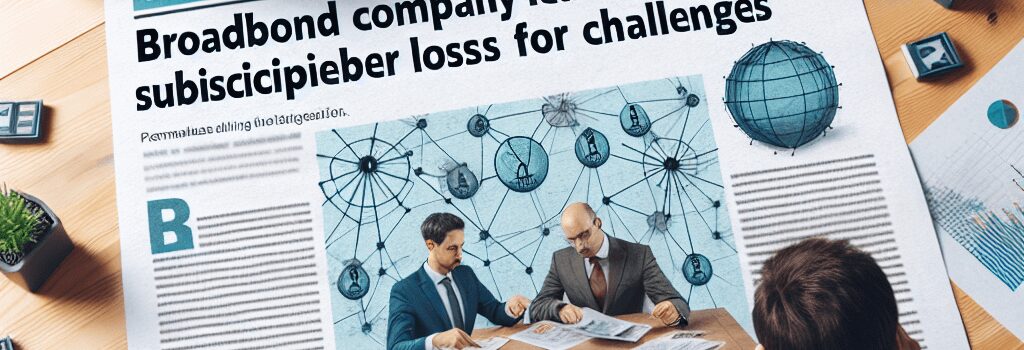Comcast President Warns of Broadband Subscriber Losses Amid Challenges

Q1 2025 Results Highlight Pricing Friction
On the April 24, 2025 earnings call, Comcast President Mike Cavanagh delivered a blunt assessment of the company’s residential broadband performance: “We are not winning.” The cable giant reported a net loss of 183,000 residential broadband subscribers in Q1 2025—three times the 61,000–subscriber decline in the same quarter last year—bringing its total to 29.19 million. Business broadband lines fell by 17,000 to 2.45 million, while mobile added 323,000 lines and video lost 427,000 customers.
- Residential broadband net loss: 183,000 subscribers (Q1 2025)
- Business broadband net loss: 17,000 subscribers
- Mobile net gain: 323,000 lines (total 8.15 million)
- Video net loss: 427,000 subscribers (total 12.1 million)
Despite a 1.7% year-over-year rise in domestic broadband revenue to $6.56 billion—indicating Comcast is extracting more ARPU from its shrinking base—investors punished the stock, sending shares down 3.7%. Executive teams attribute this subscriber erosion to two primary factors: a lack of price transparency and predictability and the complexity of doing business with Comcast.
Simplifying Pricing: Five-Year Guarantees and Beyond
In late April, Comcast unveiled a new pricing construct aimed at reducing bill shock. New residential broadband customers can lock in rates for five years, with monthly prices starting at $55 for the base tier and topping out at $105 for gigabit service. The package includes one year of Xfinity Mobile at no charge and carries no early-termination fee. However, taxes and regulatory fees remain variable and are explicitly excluded from the guarantee.
Cavanagh stressed that this is just the first step: “We are simplifying our pricing construct to make our price-to-value proposition clearer to consumers across all broadband segments. Providing more value with less complexity and friction is a top priority, and you will see our go-to-market approach continue to evolve.”
Industry observers note that while the five-year lock mitigates steep post-promotional hikes—CNET data shows typical 12-month offers often double after the first year—the starting rates are higher than many incumbent promotions. Barclays analyst Philip Cusick projects it may take “at least three to four quarters” for the new pricing to regain lost momentum.
Network Infrastructure Upgrades: DOCSIS 4.0, Fiber and Node Splitting
Comcast has invested heavily in its hybrid fiber-coax (HFC) network, deploying DOCSIS 3.1 at scale and trialing DOCSIS 4.0 in select markets. The next-generation specification promises symmetrical multi-gigabit speeds (up to 10 Gbps downstream and 6 Gbps upstream), lower latency (under 3 ms) and improved spectral efficiency through full duplex coax technology and extended spectrum usage up to 1.8 GHz.
By mid-2025, Comcast plans to roll out node-splitting across 30 metro areas to shrink service groups from 500 homes to 150, boosting per-household capacity. The company also continues to expand fiber-to-the-premises (FTTP) under its Project Infinity initiative, targeting 1 million additional premises by year’s end. FTTP deployments leverage 10G-PON (XGS-PON) to deliver true symmetrical 10 Gbps services and support future 25 Gbps upgrades.
Competitive Landscape: Fiber, Fixed Wireless and Edge Compute
Comcast’s HFC network, while robust, faces growing competition from national and regional fiber players. Verizon Fios and AT&T Fiber have collectively added over 500,000 subscribers in Q1 2025, buoyed by aggressive buildouts and triple-play bundles. Meanwhile, T-Mobile and other wireless carriers are expanding fixed wireless access (FWA) offerings using mid-band 5G, delivering 100–300 Mbps download speeds in many suburban and rural markets.
Edge compute partnerships also factor into connectivity decisions. Comcast’s Xfinity Edge platform, launched in early 2024, integrates edge servers in neighborhood hubs to accelerate video streaming and cloud gaming traffic. But rivals such as AWS Wavelength Zones and Microsoft Azure Edge Zones are moving deeper into metro footprints, providing enterprises with on-ramps to hyperscale clouds closer to end users.
Regulatory and Policy Considerations Impacting Broadband
The Federal Communications Commission’s push for “all-in” price advertising—mandated last year to curb hidden Broadcast TV and Regional Sports Network fees—remains in flux under new leadership. Comcast and other cable operators are lobbying to roll back the rule, arguing that wholesale fee structures and content carriage contracts complicate true end-to-end pricing.
At the same time, the Affordable Connectivity Program (ACP) has subsidized broadband for 14 million low-income households, with Comcast enrolling over 3 million participants. Continued funding or expiration of the ACP in late 2025 will materially affect subscriber counts and broadband penetration rates. State broadband offices are also carving out funding through the Broadband Equity, Access and Deployment (BEAD) program, potentially bolstering fiber builds in unserved areas.
Expert Analysis and Outlook
“Comcast’s network is technically world-class,” says Dana Cooperson, a senior analyst at MoffettNathanson. “However, consumers vote with their feet when they see opaque fees or unpredictable bill jumps. Simplified long-term pricing must be paired with localized marketing and better digital onboarding to stem churn.”
RBC Capital Markets broadband specialist Richard Greenfield adds: “The cable ecosystem has to accelerate DOCSIS 4.0 and FTTP timelines, while also lean-ing into AI-driven customer support bots to reduce friction. Otherwise, fiber and wireless incumbents will pick off suburban churners looking for transparent, symmetrical connectivity.”
Comcast acknowledges the road to recovery will be multi-quarter. Cavanagh concluded: “We anticipate that it will take several quarters for our new approach to gain traction and impact the business in a meaningful way. But we’re committed to winning back customers with clear, predictable pricing and an unparalleled network.”